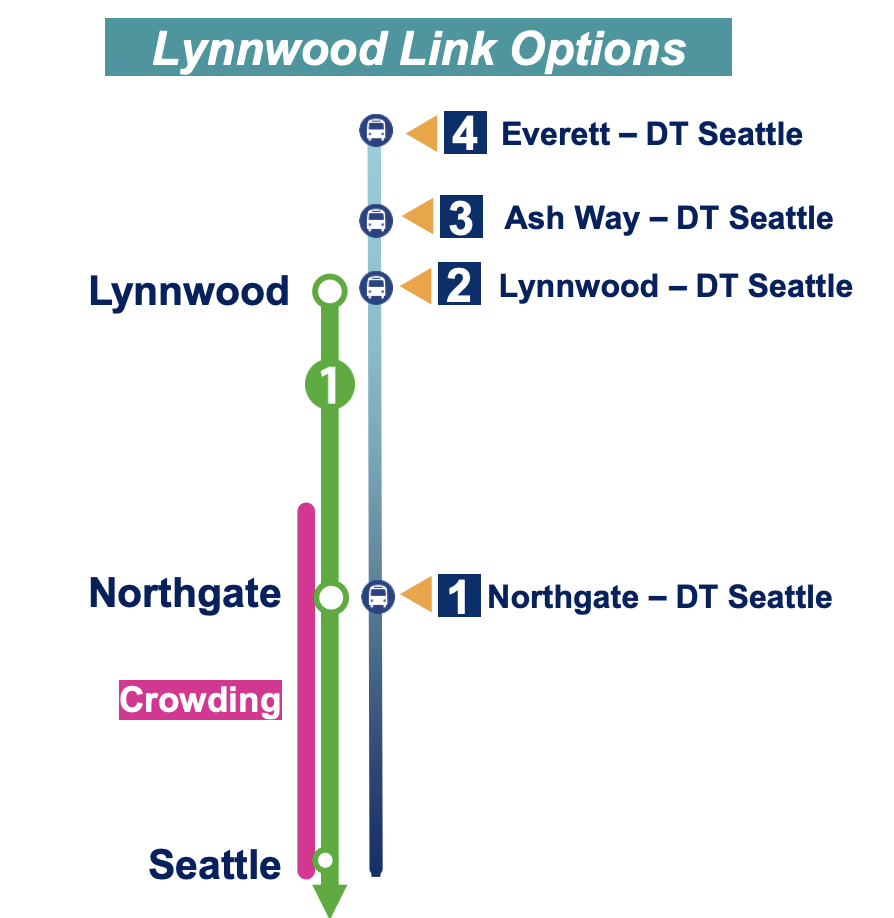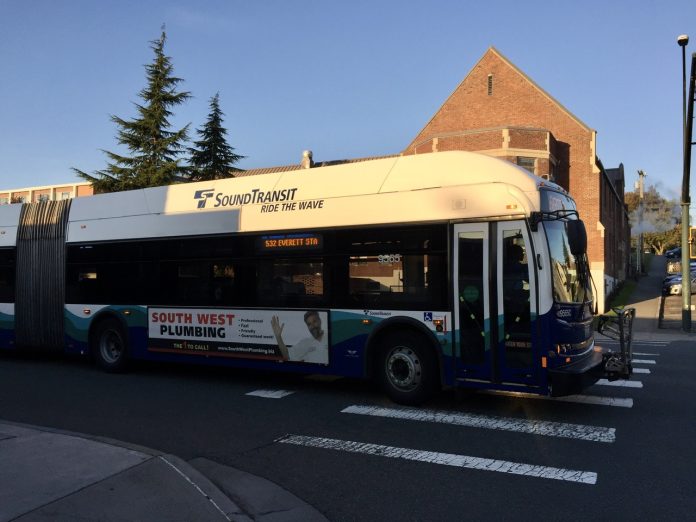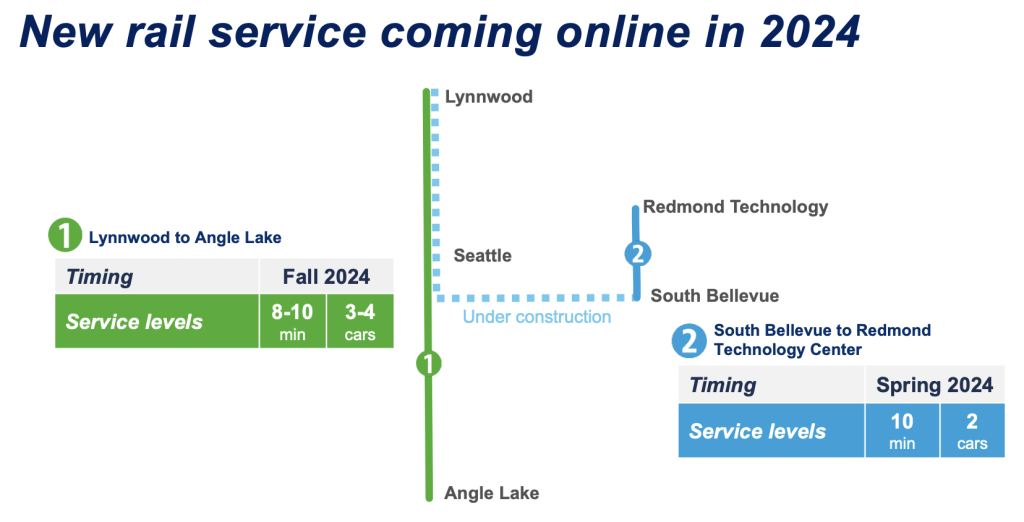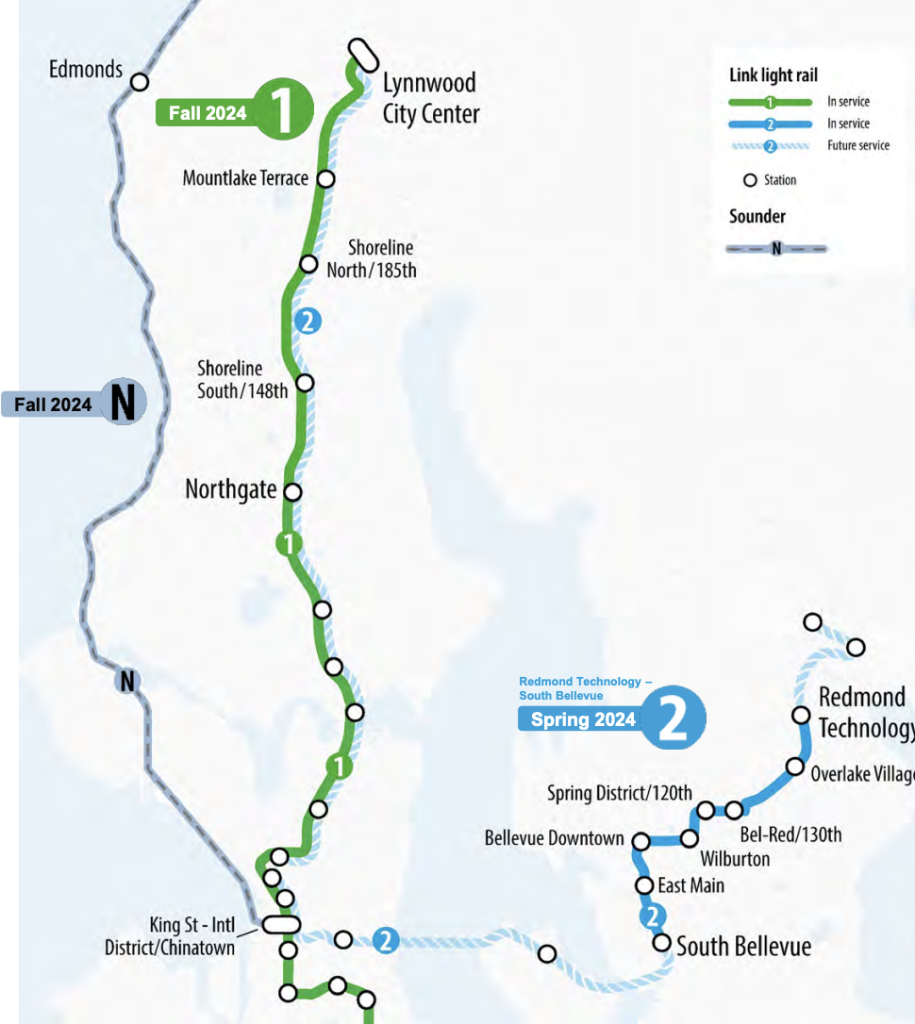Grappling with capacity constraints, Sound Transit is splitting its 2024 Service Plan into two phases, approving the rail plan but taking more time on ST Express.
Sound Transit’s service plan for 2024 has gotten a bit of a shake-up since earlier this year. Plans to consolidate and redeploy Snohomish County-Seattle ST Express bus service have fallen away and the service planning process is being broken into two phases to deal with ST Express separately.
Normally Sound Transit adopts a single service plan in the fall for implementation in the following year. But this time is different. Multiple openings of light rail next year, issues surrounding Link service levels, and difficulty in hiring and retaining transit operators and maintainers has made service planning a bigger challenge than in the past. Breaking up the service planning process into two phases is thought to better help the agency respond to emerging challenges and opportunities.
In the first phase of the 2024 Service Plan, the agency is greenlighting partial opening of the Link 2 Line on the Eastside, extending Link 1 Line service to Lynnwood, and restoring Sounder N Line trips.
In the spring, the 2 Line will launch with eight stations between South Bellevue and Redmond Technology stations. Weekday ridership is initially expected to be low — around 6,000 daily riders — since service won’t run to Seattle and points north until the I-90 section is approved for activation. Service will run seven days a week with 10-minute frequencies and two-car trains. The span of service is expected to be around 16 hours, which is shorter than the 1 Line. The first trains will start around 5:30am with service concluding around 9:30pm.
Then in the fall, the final two Sounder N Line trips will be restored and the Lynnwood Link Extension will open, adding four new stations north of Northgate.
The 1 Line is expected to see a notable service service reduction with the Lynnwood Link Extension opening. More trains will operate with three instead of four cars and weekday peak hour service will fall from eight-minute frequencies to 10-minute frequencies. That means the schedule, seven days a week, will consistently be 10-minute frequencies outside of late night periods and weekday early morning periods when frequencies will be about every 15 minutes. The agency, however, is hoping that weekday frequencies could be improved closer to the current schedule, but that will depend on a variety of factors all going right, and staff has also warned riders to brace for overcrowding.
Since this first phase of the service plan isn’t dealing with ST Express, that will be picked up in the second phase which continues through early next year. ST Express service levels are therefore targeted to remain at the 2023 level until the second phase of the service plan is approved and implemented.
A big decision point on ST Express is going to be how Snohomish County-Seattle routes are adjusted. Originally, those routes were going to be consolidated and truncated with service running only as far south as Lynnwood City Center Station. Hours saved from consolidations and truncations would then be reinvested in improving frequency and span of service. Now the question is around whether existing routes will be further extended and service characteristics once the Lynnwood Link Extension opens next fall.

Sound Transit service planning staff have outlined four general options for ST Express between Snohomish County and Seattle:
- Option 1 would simply run redundant service to Link from Northgate station to Downtown Seattle, relieving the area predicted to have the highest crowding problems. This, however, could create three-seat rides for Snohomish County riders and discourage riders from entering the transit system.
- Option 2 would fully shadow Link from Lynnwood to Downtown Seattle. This would be more effective than Option 1 but require more resources per trip.
- Option 3 would run service from Ash Way to Downtown Seattle, similar to the old Route 511 pre-Northgate Link. This would allow for more one-seat rides for Snohomish County riders into Downtown Seattle but require more resources per trip than Options 1 and 2.
- Option 4 would run from Everett to Downtown Seattle, similar to the old Routes 510 and 512 pre-Northgate Link. This would allow for more one-seat rides for Snohomish County riders into Downtown Seattle but require more resources per trip than Options 1, 2, and 3.
At a committee meeting earlier this month, Everett Mayor Cassie Franklin expressed support for options that would maximally cover Snohomish County and reach Downtown Seattle.
“I want to ensure that the bus is from Everett to and through Seattle,” Franklin said. “My riders are using [ST Express] and will be using it for another decade plus, and so that’s very necessary. And so, if we’re augmenting [Link with ST Express], it needs to be augmented all the way through Everett.”
That could be a big lift for Sound Transit since its local transit partners, which the agency relies upon for ST Express service, are struggling to provide existing service levels as it is. Extending ST Express bus routes could come at the cost of frequency and span of service, and ultimately capacity — which is the reason for shadowing Link in the first place.
Related to the questions surrounding Snohomish County-Seattle ST Express, Sound Transit is grappling with implementation of this year’s ST Express service plan. Staffing shortages at partner transit agencies has meant planned service levels haven’t been fully realized, delaying implementation of improvements, and struggling to meet normal service objectives. The second service planning phase will have to address this.
Stephen is a professional urban planner in Puget Sound with a passion for sustainable, livable, and diverse cities. He is especially interested in how policies, regulations, and programs can promote positive outcomes for communities. With stints in great cities like Bellingham and Cork, Stephen currently lives in Seattle. He primarily covers land use and transportation issues and has been with The Urbanist since 2014.




